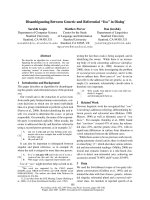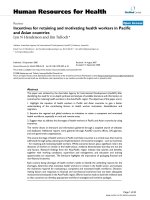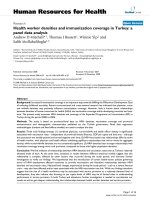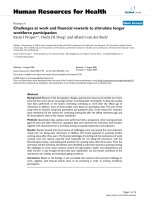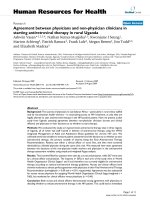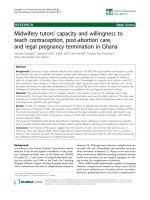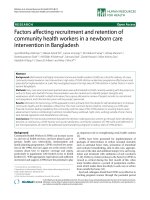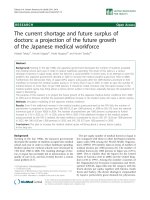báo cáo sinh học:" Agreement between physicians and non-physician clinicians in starting antiretroviral therapy in rural Uganda" docx
Bạn đang xem bản rút gọn của tài liệu. Xem và tải ngay bản đầy đủ của tài liệu tại đây (609.78 KB, 11 trang )
BioMed Central
Page 1 of 11
(page number not for citation purposes)
Human Resources for Health
Open Access
Research
Agreement between physicians and non-physician clinicians in
starting antiretroviral therapy in rural Uganda
Ashwin Vasan*
1,2,3,4
, Nathan Kenya-Mugisha
3,5
, Kwonjune J Seung
1
,
Marion Achieng
3
, Patrick Banura
3
, Frank Lule
5
, Megan Beems
2
, Jim Todd
4,6
and Elizabeth Madraa
5
Address:
1
Partners In Health, Boston, Massachusetts, USA,
2
University of Michigan Medical School, Ann Arbor, Michigan, USA,
3
Masaka Regional
Referral Hospital, Ministry of Health, Masaka, Uganda,
4
London School of Hygiene & Tropical Medicine, London, UK,
5
National STI/AIDS
Programme, Ministry of Health, Kampala, Uganda and
6
Medical Research Council, Entebbe and Masaka, Uganda
Email: Ashwin Vasan* - ; Nathan Kenya-Mugisha - ; Kwonjune J Seung - ;
Marion Achieng - ; Patrick Banura - ; Frank Lule - ;
Megan Beems - ; Jim Todd - ; Elizabeth Madraa -
* Corresponding author
Abstract
Background: The scarcity of physicians in sub-Saharan Africa – particularly in rural clinics staffed
only by non-physician health workers – is constraining access to HIV treatment, as only they are
legally allowed to start antiretroviral therapy in the HIV-positive patient. Here we present a pilot
study from Uganda assessing agreement between non-physician clinicians (nurses and clinical
officers) and physicians in their decisions as to whether to start therapy.
Methods: We conducted the study at 12 government antiretroviral therapy sites in three regions
of Uganda, all of which had staff trained in delivery of antiretroviral therapy using the WHO
Integrated Management of Adult and Adolescent Illness guidelines for chronic HIV care. We
collected seven key variables to measure patient assessment and the decision as to whether to start
antiretroviral therapy, the primary variable of interest being the Final Antiretroviral Therapy
Recommendation. Patients saw either a clinical officer or nurse first, and then were screened
identically by a blinded physician during the same clinic visit. We measured inter-rater agreement
between the decisions of the non-physician health workers and physicians in the antiretroviral
therapy assessment variables using simple and weighted Kappa analysis.
Results: Two hundred fifty-four patients were seen by a nurse and physician, while 267 were seen
by a clinical officer and physician. The majority (> 50%) in each arm of the study were in World
Health Organization Clinical Stages I and II and therefore not currently eligible for antiretroviral
therapy according to national antiretroviral therapy guidelines. Nurses and clinical officers both
showed moderate to almost perfect agreement with physicians in their Final Antiretroviral Therapy
Recommendation (unweighted κ = 0.59 and κ = 0.91, respectively). Agreement was also substantial
for nurses versus physicians for assigning World Health Organization Clinical Stage (weighted κ =
0.65), but moderate for clinical officers versus physicians (κ = 0.44).
Conclusion: Both nurses and clinical officers demonstrated strong agreement with physicians in
deciding whether to initiate antiretroviral therapy in the HIV patient. This could lead to immediate
Published: 20 August 2009
Human Resources for Health 2009, 7:75 doi:10.1186/1478-4491-7-75
Received: 11 February 2009
Accepted: 20 August 2009
This article is available from: />© 2009 Vasan et al; licensee BioMed Central Ltd.
This is an Open Access article distributed under the terms of the Creative Commons Attribution License ( />),
which permits unrestricted use, distribution, and reproduction in any medium, provided the original work is properly cited.
Human Resources for Health 2009, 7:75 />Page 2 of 11
(page number not for citation purposes)
benefits with respect to antiretroviral therapy scale-up and decentralization to rural areas in
Uganda, as non-physician clinicians – particularly clinical officers – demonstrated the capacity to
make correct clinical decisions to start antiretroviral therapy. These preliminary data warrant more
detailed and multicountry investigation into decision-making of non-physician clinicians in the
management of HIV disease with antiretroviral therapy, and should lead policy-makers to more
carefully explore task-shifting as a shorter-term response to addressing the human resource crisis
in HIV care and treatment.
Background
Since the December 2003 launch of the "3 by 5" Initiative
by the World Health Organization (WHO) and the Joint
United Nations Programme on HIV/AIDS (UNAIDS) [1],
global access to antiretroviral therapy (ART) for HIV/AIDS
has grown dramatically. As of the end of 2007 – the last
published global estimate – nearly three million persons
were receiving ART in low-income and middle-income
nations; a greater than sevenfold increase in the number
of persons on treatment in a period of four years [2]. Cov-
erage in sub-Saharan Africa – the region with the highest
HIV burden in the world – has increased nearly 20-fold in
this same period [2].
This rapid scale-up of HIV treatment has revealed a
number of weaknesses in health systems in developing
countries, most notably the glaring shortage of medical
doctors and other health workers trained to deliver HIV/
AIDS care and treatment with ART. WHO estimates that
more than four million health workers are needed to fill
existing human resource gaps [3,4]. Nowhere is this more
important than in sub-Saharan Africa, which has 11% of
the world's population and 24% of its disease burden, but
only 3% of its health workers [3]. The shortage of trained
clinicians has been identified as a major impediment to
the widespread provision of ART in low-resource settings
[5,6], and it has been suggested that this gap alone threat-
ens the sustainability of the entire enterprise of HIV treat-
ment scale-up in the developing world [7].
In response to these known deficits, and in the context of
ambitious multilateral efforts to ensure "universal access"
to HIV/AIDS prevention, treatment, care and support by
2010 [8,9], WHO and partners have called for a compre-
hensive approach to strengthening human resource capac-
ity, which includes making more efficient use of existing
health workers, most notably through "task-shifting" –
delegation of discrete clinical and programmatic tasks and
responsibilities from more-specialized to less-specialized
cadres of health workers [10].
In support of a public health approach to treating HIV
within government health systems [11], within which
task-shifting is a key pillar, WHO and partners developed
the Integrated Management of Adolescent and Adult Ill-
ness (IMAI) programme, which includes training and
supervision modules based on simplified, syndromic clin-
ical algorithms for managing uncomplicated HIV disease
with ART, targeted primarily at non-specialist physicians
and non-physician clinicians (clinical officers, medical
assistants, nurses, etc.) based at first-line health facilities
(mainly primary health centres and district hospitals)
[12]. IMAI is currently being implemented in more than
30 countries, principally in sub-Saharan Africa.
The use of non-physician clinicians (NPCs) – particularly
nurses – in health care delivery is legitimized and standard
practice in developed nations [13-16], especially in the
context of chronic disease management for diabetes,
chronic gastrointestinal illness and chronic pain syn-
dromes, to name only a few conditions. In outpatient
HIV/AIDS care, NPCs in industrialized nations play a cen-
tral role in ensuring patient follow-up, providing adher-
ence support and counselling, and managing and triaging
therapy side effects. One United States review even sug-
gested that nurse practitioners and physician assistants
delivered higher-quality HIV care and treatment than gen-
eral internist physicians [17].
In the developing world formal progress has been slower,
but NPCs have still proven invaluable in clinical care and
are critical actors within the health system. The first docu-
mented models of health care delivery heavily incorporat-
ing NPCs demonstrated modest evidence of success and
the maintenance of good-quality care [18,19]. With
respect to HIV care and treatment, many countries rely
increasingly on NPCs to deliver care due to shortages of
physicians, particularly in rural areas where the few avail-
able physicians are unlikely or unwilling to practise
[20,21]. These approaches are beginning to produce posi-
tive results.
Bedulu and colleagues in Lusikisiki, South Africa, reported
that a decentralized model of ART delivery that focuses on
rural HIV clinics run by NPCs showed faster and larger
(fourfold) patient enrolment, lower loss to follow-up, and
satisfactory clinical outcomes (immunological and viro-
logical suppression) when compared to the local district
hospital run by physicians [22]. Another South African
group reported comparable non-randomized six-month
Human Resources for Health 2009, 7:75 />Page 3 of 11
(page number not for citation purposes)
ART outcomes in patients receiving care from clinics with-
out physicians to those with physicians [23].
Yet despite these preliminary successes, the widespread
adoption of such policies in sub-Saharan African coun-
tries has been relatively slow, due in part to the lack of evi-
dence that high-quality care and clinical decision-making
can be maintained by task-shifting to NPCs [24]. There is
concern among public health experts not only about the
capacity of NPCs (in light of the variable quality of train-
ing and their many other competing tasks, particularly in
primary health clinics) to appropriately initiate therapy
and manage chronic HIV disease, but also about main-
taining long-term treatment adherence and early identifi-
cation of treatment failure, which could have implications
for the development and proliferation of drug-resistant
disease [24].
As evidence of the prevailing reticence to adopt HIV pro-
grammes that give NPCs greater clinical responsibility,
Ethiopia, Kenya and Malawi are the only countries that
currently legally allow Clinical Officers to prescribe ART
[25], and only recently did the Government of Malawi
approve limited ART initiation by nurses [25]. In many
sub-Saharan African countries, NPCs provide ART and
HIV care on an informal basis, but this is sporadic, as it
lacks legal mandate in most countries. Uganda is another
country that has demonstrated early leadership in this
regard, adopting a decentralized approach to ART scale-up
– based on the WHO/IMAI Strategy – as the framework for
its National ART Plan [26]. The Government of Uganda
has actively explored and pilot-tested initiatives that
enhance the role of NPCs in the delivery of HIV care and
treatment.
Here we present the results of a pilot study of clinical deci-
sion-making in HIV management, assessing the strength
of agreement between NPCs and non-specialist physi-
cians (MDs, medical officers) in their basic patient evalu-
ation and recommendation for ART initiation in patients
attending rural and semi-rural hospitals and primary care
clinics in Uganda. The purpose of this study is to contrib-
ute to the evidence base for decentralization and task-
shifting of ART in under-resourced government health
systems and to provide data to guide and improve future
HIV training programmes targeted at NPCs.
Methods
Study sites
The study was conducted at 12 official government-run
ART sites based at district hospitals and subdistrict pri-
mary care clinics in three regions of Uganda (South/Cen-
tral, North and East/Southeast). These sites were selected
on the basis of their large outpatient HIV programmes and
the presence of a full-time, on-site, physician, clinical
officer and nurse trained in management of HIV/AIDS
through the Ministry of Health programme that was
adapted from generic WHO/IMAI protocols. To ensure
that ART training was equivalent across clinics and health
workers, we selected sites that were not receiving addi-
tional financial and/or technical support for HIV pro-
grammes from private and/or nongovernmental
organizations, as institution-specific supplemental train-
ing and clinical protocols are often implemented in this
context. Sites were also selected from rural and semi-rural
areas, so as to gather outcomes that more accurately reflect
practice under a decentralized approach to ART delivery.
Study sites did not have HIV viral load testing, and only
limited access to CD4+ cell counts was available.
Health workers
Health workers were classified as physicians, clinical offic-
ers and nurses (nurse officers, nursing assistants, nurse-
midwives). Physicians were defined in the general sense of
having completed a requisite six-year medical school pro-
gramme plus a one-year internship, rather than possessing
specialist qualifications, and this definition is used
throughout this manuscript. Clinical officers were defined
by three years' pre-service education plus two years'
internship; and nurses, more variably, by one to four years
of formal nursing education (with or without midwifery)
[27].
All health workers were trained in delivering chronic HIV
care and treatment during the period from June 2004 –
when IMAI training was first conducted in Uganda by
WHO and the Ministry of Health – and June 2006. At the
time of the study, all health workers were active partici-
pants in their site's HIV treatment programme as mem-
bers of the clinical care team. Due to the frequent job
turnover in this population as a result of migration to
urban centres, to the private sector or abroad to industri-
alized nations, we were unable to control for the number
of years of postgraduate professional service in selecting
health workers for this study, and considered only their
baseline education and HIV training.
Study design
From July to September 2006, consecutive HIV-positive
adults ≥18 years old, not currently on ART and presenting
to any one of the 12 study sites were offered enrolment
into the study. Written informed consent was obtained in
their respective local language. Patients were first assessed
by the participating clinical officer or nurse at the site. All
patients were then assessed by the physician.
Each clinician completed the same patient assessment and
ART recommendation questionnaire as part of a compre-
hensive patient workup and were blinded to the findings
of the other clinicians for the same patient. After assess-
ment by two different health care workers, patients
received the remainder of care according to routine proce-
Human Resources for Health 2009, 7:75 />Page 4 of 11
(page number not for citation purposes)
dures at the clinic. All final clinical decisions and treat-
ment plans for that patient were made by the physician.
Patients at each clinic were allotted to see the nurse or
clinical officer for their first assessment based on 50-
patient block randomization of a total of 600 patients,
performed centrally by the study team. This was done to
mitigate potential variation and selection bias (e.g. by dis-
ease severity, specific opportunistic infections, etc.) in the
types of patients seen initially by each NPC cadre.
Detailed patient flow in the study is shown in Figure 1.
Study assessment
Study clinicians gathered seven basic pieces of informa-
tion based on simplified WHO/IMAI algorithms for
patient assessment and recommendation for initiation of
ART. The primary outcome of interest was the Final ART
Recommendation by the clinician – whether or not and/
or when the patient should be started on ART. The second-
ary outcomes – WHO clinical stage, functional status, TB
status, stabilization of opportunistic infections, any abso-
lute exceptions to immediate ART initiation, and patient
readiness for ART initiation – were also collected and were
intended to inform the final ART recommendation.
Exceptions to starting ART and patient readiness were
gathered as binary variables, though the patient had to be
evaluated for all categorical subcriteria before a final Yes/
No decision was made on these variables (Additional file
1).
Data analysis
For the seven variables of interest in the study, including
the final ART recommendation, analysis of inter-rater
agreement for each patient was conducted separately in
two arms, comparing clinical officer versus physician, and
Study flow chartFigure 1
Study flow chart.
Human Resources for Health 2009, 7:75 />Page 5 of 11
(page number not for citation purposes)
nurse versus physician. Unweighted and quadratic-
weighted Kappa analysis (weights assigned by Stata) was
used to compare the level of agreement for each variable
as assessed independently by the two clinician cadres.
Weighted analysis is particularly important for ordered
categorical variables (such as WHO clinical stage), where
disagreements in assessment belonging to adjacent cate-
gories (e.g. stage 2 versus stage 3) are of less clinical
importance than those that are farther apart (e.g. stage 1
versus stage 4) and are less relevant for binary or non-ordi-
nal categorical data [28], though both are reported. Of
note, quadratic-weighted Kappa statistics almost exactly
correspond to the ANOVA estimator for the intraclass cor-
relation coefficient, which we confirmed but did not
include in our results. Data analysis was performed with
Stata v8 (College Station, TX, United States of America).
Common interpretation of strength of agreement based
on the Kappa statistic is given in Table 1[29].
Results
Study enrolment
Of 521 eligible patients who consented to participate in
the study, 254 patients were seen in the nurse versus phy-
sician arm, while 267 patients were seen in the clinical
officer versus physician arm.
Frequency distribution for study outcomes
Frequency distribution for each variable in the nurse ver-
sus physician and clinical officer versus physician study
arms are shown in Table 2. In the nurse versus physician
arm, 151 (59.5%) patients were found to be medically
ineligible for ART by the physician, and 156 (61.4%) by
the nurse. In the clinical officer versus physician arm, 146
(54.7%) patients were found to be medically ineligible by
both health care worker groups.
Correspondingly, 61% of patients were found by the
nurse to be in WHO clinical stages 1 and 2, and 56.7% of
patients by the physician. The same was true for the clini-
cal officer versus physician arm, where 48.3% of patients
were assigned to stage 1 or 2 by the clinical officer, and
55% by the physician.
By contrast, only 16 (6.3%) patients were recommended
by the nurse to start first-line therapy of stavudine + lam-
ivudine + nevirapine (d4T/3TC/NVP), while 10 (3.9%)
were recommended by the physician. This held true for
the clinical officer versus physician arm as well, where
only 8 (3.0%) patients were recommended to start d4T/
3TC/NVP by the nurse, while 16 (6.0%) were recom-
mended by the physician.
Forty-two (6.5%) patients were found to have active TB by
the nurse, while 53 (20.9%) were classified as having
active TB according to the physician. In the clinical officer
versus physician arm, 56 (21.0%) patients were found to
have active TB by the clinical officer, while 58 (21.7%)
were found by the physician.
The majority of patients in the nurse versus physician arm
had their functional status classified as Working (able to
work) – 221 (87.0%) classified by the nurse and 203
(79.9%) by the physician. The same was true for the clin-
ical officer versus physician arm, where 197 (73.8%)
patients were classified as Working by the clinical officer
and 190 (71.2%) by the physician.
Kappa analysis of inter-rater agreement
Detailed results of Kappa analysis for the nurse versus
physician arm and the clinical officer versus physician
arm are presented in Tables 3 and 4, respectively. In the
nurse versus physician arm, actual agreement on ART rec-
ommendation was 77.9%, compared with agreement of
45.9% expected by chance. This produced an unweighted
Kappa statistic of 0.59 (± 0.05), which falls within the
high end of the category of "moderate" strength of agree-
ment (Table 1). For WHO clinical stage, unweighted anal-
ysis resulted in a Kappa statistic of 0.54 (± 0.04), while
weighted analysis showed a Kappa of 0.65 (± 0.06), clas-
sified as "substantial" strength of agreement (30). Assess-
ment of current TB status showed actual agreement of
85.9%, agreement of 60.8% expected by chance, and a
Kappa coefficient of 0.64 (± 0.05). Assignment of func-
tional status produced an actual rate of agreement of
82.7%, versus agreement of 71.1% expected by chance,
resulting in a Kappa statistic of 0.40 (± 0.05).
The unweighted Kappa statistic for final ART recommen-
dation in the clinical officer versus physician arm was
0.91( ± 0.05), based on an actual rate of agreement of
95.1%, versus agreement of 43.1% expected by chance.
Weighted Kappa analysis of WHO clinical stage produced
a κ = 0.44 ( ± 0.06), while unweighted analysis of TB sta-
tus produced a κ = 0.58 ( ± 0.05). Weighted analysis
assessing the treatment and/or stabilization of current
opportunistic infections produced a κ = 0.42 ( ± 0.06) – a
"moderate" strength of agreement.
Table 1: Interpretation of Kappa coefficient values between 0
and 1
Strength of agreement
0.00–0.20 Slight
0.21–0.40 Fair
0.41–0.60 Moderate
0.61–0.80 Substantial
0.81–1.00 Almost perfect
Source: Landis JR, Koch GG: The measurement of observer
agreement for categorical data. Biometrics 1977, 33:159–175.
Human Resources for Health 2009, 7:75 />Page 6 of 11
(page number not for citation purposes)
Table 2: Frequency table of basic ART assessment findings by non-physicians versus physicians
Nurse versus physician arm Clinical Officer versus physician arm
Nurse
(n (N%))
Physician
(n (N%))
Clinical Officer
(n (N%))
Physician
(n (N%))
Final ART recommendation
Start on d4T/3TC/NVP 16 (6.3) 10 (3.9) 8 (3.0) 16 (6.0)
Start on other ART regimen 5 (2.0 10 (3.9) 1 (0.4) 5 (1.9)
Medically eligible, but coexisting condition needs referral 4 (1.6) 3 (1.2) 3 (1.1) 3 (1.1)
Medically eligible, but needs more adherence, psychosocial prep 72 (28.3) 80 (31.5) 96 (35.9) 96 (35.9)
Not medically eligible 156 (61.4) 151(59.5) 146 (54.7) 146 (54.7)
Missing 1 (0.4) 0 13 (4.9) 1 (0.4)
WHO stage
Stage 1 49 (19.3) 50 (19.7) 44 (16.5) 51 (19.1)
Stage 2 106 (41.7) 94 (37.0) 85 (31.8) 96 (35.9)
Stage 3 82 (32.3) 94 (37.0) 114 (42.7) 94 (35.2)
Stage 4 12 (4.7) 16 (6.3) 20 (7.5) 25 (9.4)
Missing 5 (2.0) 0 4 (1.5) 1 (0.4)
Functional status
Working 221 (87.0) 203 (79.9) 197 (73.8) 190 (71.2)
Ambulatory 24 (9.4) 40 (15.7) 57 (21.3) 59 (22.1)
Bedridden 4 (1.6) 6 (2.4) 4 (1.5) 8 (3.0)
Missing 5 (2.0) 5 (2.0) 9 (3.4) 10 (3.7)
General TB status
No suspicion 199 (78.3) 185 (72.8) 196 (73.4) 188 (70.4)
Suspect TB (cough>3 wks) 12 (4.7) 15 (5.9) 15 (5.6) 17 (6.4)
Active TB 42 (16.5) 53 (20.9) 56 (21.0) 58 (21.7)
Missing 1 (0.4) 1 (0.4) 0 4 (1.5)
Opportunistic infections treated and/or stabilized
No 94 (37.0) 57 (22.4) 65 (24.3) 80 (30.0)
Yes 133 (52.4) 150 (59.1) 158 (59.2) 132 (49.4)
Human Resources for Health 2009, 7:75 />Page 7 of 11
(page number not for citation purposes)
Missing 27 (10.6) 47 (18.5) 44 (16.5) 55 (20.6)
No absolute exceptions to starting ART immediately
No 45 (17.7) 54 (21.2) 61 (22.8) 62 (23.2)
Yes 108 (42.5) 102 (40.2) 99 (37.1) 96 (36.0)
Missing 101 (39.8) 98 (38.6) 107 (40.1) 109 (40.8)
Patient ready to begin ART
No 106 (41.7) 62 (24.4) 140 (52.4) 63 (23.6)
Yes 62 (24.4) 87 (34.3) 51 (19.1) 94 (35.2)
Missing 86 (33.9) 105 (41.3) 76. (28.5) 110 (41.2)
SUBTOTAL (N) 254 254 267 267
Table 2: Frequency table of basic ART assessment findings by non-physicians versus physicians (Continued)
Table 3: Nurse-versus-physician agreement in patient assessment and recommendation of initiation of antiretroviral therapy
% Agreement % Agreement expected by
chance
Kappa ± SE (unweighted) Kappa ± SE (weighted)
ART recommendation 77.9 45.9 0.59 ± 0.05 -
95 86.8 - 0.62 ± 0.06
WHO stage 68.5 31.5 0.54 ± 0.04 -
96.6 90.4 - 0.65 ± 0.06
Functional status 82.7 71.1 0.40 ± 0.05 -
92.1 86.9 - 0.40 ± 0.05
TB status 85.8 60.8 0.64 ± 0.05 -
90.9 77.1 - 0.61 ± 0.06
Opportunistic infections treated/
stabilized
61 41.2 0.34 ± 0.05 -
77.4 66 - 0.33 ± 0.04
Absolute exceptions to starting
ART
51.6 36.2 0.24 ± 0.05 -
79.3 72.6 - 0.25 ± 0.06
Patient is ready to begin ART 50.4 32.5 0.26 ± 0.04 -
76.1 64 - 0.34 ± 0.06
Human Resources for Health 2009, 7:75 />Page 8 of 11
(page number not for citation purposes)
Discussion
This study demonstrates considerable strength of agree-
ment between NPCs and physicians in their basic patient
assessment and their recommendation to initiate antiret-
roviral therapy in HIV-positive patients in rural Uganda.
Among the seven study variables, nurses and physicians
had the strongest agreement in their final ART recommen-
dation, their assignment of WHO clinical stage, and their
assessment of current TB status. Clinical officers and phy-
sicians also showed the strongest – almost perfect – agree-
ment in their final ART recommendation and TB status,
but had lower strength of agreement for WHO clinical
stage than nurses and physicians. As could be reasonably
expected, given their level of education and training,
agreement between clinical officers and physicians – par-
ticularly for the final ART recommendation – was gener-
ally stronger than for nurses versus physicians. The
reduced strength of agreement for the secondary variables,
such as patient readiness for ART, may be explained by
their high level of subjectivity in application, as well as a
significant amount of missing data.
Several limitations must be considered in interpreting the
findings of this study. First, given that this was a pilot, we
focused on key variables that reflect the clinical decisions
that are most important in deciding whether or not to ini-
tiate ART in a patient. These variables have been outlined
in the WHO IMAI guidelines [12] and provide a simpli-
fied framework within which to make accurate clinical
decisions with respect to chronic HIV disease manage-
ment under resource constraints (e.g. lack of diagnostic
and laboratory infrastructure, lack of highly specialized
physicians and health care workers, and the restricted
antiretroviral formulary available). These seven variables
also reflect current clinical and diagnostic practice in
Uganda, as country-adapted versions of the WHO IMAI
training guidelines serve as the framework for the national
ART scale-up plan and are the basis for nationwide train-
ing of health care workers in ART delivery.
A more extensive analysis could have collected additional
variables that examine not only the clinical decision itself,
but also how the health care worker arrived at that deci-
Table 4: Clinical officer-versus-physician agreement in patient assessment and recommendation of initiation of antiretroviral therapy
% Agreement % Agreement expected by
chance
Kappa ± SE (unweighted) Kappa ± SE (weighted)
ART recommendation 95.1 43.1 0.91 ± 0.05 -
95.8 82.8 - 0.76 ± 0.04
WHO stage 51.7 30.3 0.31 ± 0.04 -
94.2 89.7 - 0.44 ± 0.06
Functional status 72.3 57.4 0.35 ± 0.05 -
86.6 80.8 - 0.31 ± 0.05
TB status 81.7 56.6 0.58 ± 0.05 -
88.5 74.5 - 0.55 ± 0.06
Opportunistic infections
treated/stabilized
56.6 39.9 0.28 ± 0.04 -
86.9 77.5 - 0.42 ± 0.06
Absolute exceptions to
starting ART
57.3 35 0.31 ± 0.04 -
71 58.2 - 0.31 ± 0.05
Patient is ready to begin
ART
51.3 30.8 0.30 ± 0.04 -
74.1 61.5 - 0.33 ± 0.05
Human Resources for Health 2009, 7:75 />Page 9 of 11
(page number not for citation purposes)
sion – in other words, whether the final decision to initi-
ate ART was internally consistent with the preceding
variables collected that provided the necessary data to
make an informed clinical decision. We could have done
a separate subanalysis within each arm to assess this inter-
nal consistency, but this was not the primary objective of
this pilot study.
In addition, we could have separately coded as independ-
ent variables all the contributing subcriteria for binary var-
iables such as patient readiness and exceptions to starting
ART. In the interests of simplicity as a pilot, and so as to
execute this study within the parameters of normal clinic
operations based on existing guidelines and tools, we
selected only a few of the most important variables for
investigation.
Additional limitations were created by the variation in the
timing of training of health care workers at the different
study sites. While all study clinicians received the same
ART training from the Uganda's Ministry of Health, based
on the WHO/IMAI guidelines, not all health care workers
were trained at the same time, and not all study sites
received the same frequency and quality of supportive
supervision visits as follow-up to the initial two-week
training of the clinical team. Sites in Masaka district in
southwest Uganda, for example, were the first to be
trained, in June 2004, whereas other sites in northern
Uganda received training in 2006, closer to the start date
of the study. Subanalysis by site did not show significant
differences in agreement between sites, but future studies
could eliminate potential variation by studying health
care worker cohorts that received training and follow-up
simultaneously.
Consideration must also be given to variation in the level
of training of the Ugandan nurses in our study. For sim-
plicity and ease of implementation of the study, nurses of
all levels were categorized similarly in this study, so long
as they had received the nursing-level ART/IMAI training
from the Ministry of Health. This grouping did not
account for differences in the baseline level of profes-
sional education, training, years of work experience and
skills of each nurse in the study (e.g. nurse officers, nurse
assistants and nurse-midwives), though it was a necessary
accommodation that reflected the on-the-ground reality
at first-line health facilities. Efforts are currently under
way by the Ministry of Health to standardize nursing
training and to reduce the wide variation in education and
training between nurses working at government health
units, particularly those in rural areas where less special-
ized health care workers are required, given current
human resource constraints [personal communication,
NK Mugisha, Ministry of Health].
A third layer of independent validation and corroboration
of clinical decisions could also have been useful, perhaps
through chart review or actual patient examination by an
expert infectious disease and/or HIV physician. This was
not done due to resource constraints of the study and effi-
ciency considerations, and also to avoid disruption of
normal clinic procedures as much as possible. While addi-
tional expert validation of clinical judgment could have
been useful in developing a true "gold standard" and in
the subsequent interpretation of the results, this study
reflects the clinical reality in which ART is delivered in
Uganda – and in much of sub-Saharan Africa – where the
decision of the non-specialist physician is the accepted
gold standard for the prescription of ART, particularly at
peripheral levels of the health system.
This study focuses on clinical decision-making as a proxy
for quality of care and to serve as an indication of the clin-
ical judgement and quality of HIV care that could be deliv-
ered by NPCs. A more extensive study, beyond the
purview of this investigation, could examine more tradi-
tional outcomes (e.g. survival, clinical, immunological
and virological suppression, adherence and complica-
tions) as measures of quality of HIV care delivered by
NPCs versus physicians. There are ethical considerations,
however, that must be considered in designing rand-
omized trials that compare ART delivery and other HIV
interventions delivered by non-physicians versus physi-
cians. Studies such as this would be a necessary prerequi-
site to any randomized trial comparing patient care
delivered by different health worker cadres.
To our knowledge, this is the first study of its kind – either
in industrialized or developing countries – to compare
clinical decision-making between health care worker cad-
res in their prescription of antiretroviral therapy. This
study shows that at baseline, under routine conditions at
rural health facilities, and without any particular targeted
increase in training or supervision of health care workers
outside the national framework, there is agreement in the
clinical judgement of NPCs and physicians with respect to
the evaluation and initiation of ART in patients at rural
health facilities.
As a pilot study, the results provide sufficient evidence for
further and more comprehensive evaluation of clinical-
decision making and quality of care between health care
worker cadres with respect to ART initiation and other key
clinical decisions with respect to the management of HIV
in the chronic care, outpatient setting (e.g. management
of side effects, treatment adherence, treatment failure,
severe complications requiring referral, etc.). More com-
prehensive study is warranted to establish a more robust
evidence base on which to weigh specific policy decisions
Human Resources for Health 2009, 7:75 />Page 10 of 11
(page number not for citation purposes)
to increase the participation and responsibility of NPCs in
the delivery of ART in the developing world, particularly
in sub-Saharan Africa.
Additionally, this study provides initial validation of the
WHO/IMAI training programme as an effective algorithm
for the initiation of ART at the first-level health facility.
IMAI is an important simplified tool that can be used
effectively by NPCs and physicians alike as a guide for
making treatment decisions with a limited formulary and
limited diagnostic and laboratory infrastructure. A com-
prehensive, multicountry, validation study is indicated
based on the results of this pilot and would provide
important data to encourage the more rapid and wide-
spread adoption and adaptation of IMAI and other like
modules in developing countries that face similar human
resource constraints to Uganda.
Conclusion
This study offers preliminary evidence to support
increased investment in task-shifting and training of NPCs
to deliver ART in rural primary care settings. The results of
this study can offer some alleviation of concerns about
maintaining quality of care and accurate clinical decisions
under an approach to ART scale-up that is based on decen-
tralization to rural areas and that uses task-shifting as a
central component.
The ongoing scarcity of physicians in rural areas and
increasing responsibility of NPCs for initiating ART could
eliminate a significant bottleneck to the rapid-scale up of
ART in rural and semirural areas where physicians are in
short supply, and this study provides preliminary evi-
dence that this shift can be implemented without major
concerns of a drop-off in quality compared to current
standards of care. At the least, there is compelling evi-
dence in these results that clinical officers should be
allowed to initiate ART immediately, and can do so with
a high level of agreement with physicians. This could offer
a short-term improvement in ART coverage at sites where
clinical officers are stationed, while additional resources
are targeted at strengthening the training and support of
nurses.
More detailed and multi-country evaluation of this
approach to ART initiation, as well as other key aspects of
HIV care and treatment, is warranted and will provide fur-
ther evidence as to the feasibility and effectiveness of scal-
ing up a task-shifted approach to ART scale-up that
prioritizes delivery by currently available non-physician
health workers.
Abbreviations
AIDS: acquired immunodeficiency syndrome; ART:
antiretroviral therapy; HIV: human immunodeficiency
virus; IMAI: Integrated Management of Adult and Adoles-
cent Illness; NPC: non-physician clinician; UNAIDS: Joint
United Nations Programme on HIV/AIDS; WHO: World
Health Organization.
Competing interests
The authors declare that they have no competing interests.
Authors' contributions
AV was responsible for the design, implementation and
coordination of the study, and was responsible for data
analysis and writing the first draft of the manuscript. NKM
helped to coordinate and support the field sites for study
implementation, was involved at the design phase of the
study and was involved in drafting all versions of the man-
uscript to date. KJS provided integral technical and edito-
rial comments to all drafts of the manuscript. MA was
responsible for on-site data management and coordina-
tion, including design and support of the study database
and initial data entry. PB provided critical research and
clinical support to the study sites, and provided technical
inputs to the manuscript. FL was responsible for study
coordination from the Ministry of Health, and was
involved in drafting of all versions of the manuscript. MB
was responsible for final data entry and data quality con-
trol. JT was involved in study design and coordination,
and provided overall statistical coordination for the
project, in addition to aiding data analysis and interpreta-
tion of results. EM provided overall study approval, sup-
port, coordination and technical assistance from the
Ministry of Health.
Additional material
Acknowledgements
The authors would like to thank the Institute of Public Health at Makerere
University, Kampala, Uganda, for their technical support and research
assistance with this project. They also thank Sandy Gove and Abdikamal
Alisalad from the WHO for their vigorous support and advocacy for this
project. Thanks to Tim Hofer for his critical review and comments on the
manuscript, and additional thanks go to Cheryl Moyer and David Stern and
the Global REACH team at the University of Michigan Medical School for
their support and feedback into the production of this paper. Most impor-
tantly, the authors thank the courageous and noble health workers who
participated in this study and who continue their daily work under innumer-
able constraints. Their dedication and perseverance are remarkable.
Additional file 1
Basic patient assessments for initiation of antiretroviral therapy
(ART) based on WHO IMAI guidelines. Table in landscape orientation.
Click here for file
[ />4491-7-75-S1.doc]
Publish with Bio Med Central and every
scientist can read your work free of charge
"BioMed Central will be the most significant development for
disseminating the results of biomedical research in our lifetime."
Sir Paul Nurse, Cancer Research UK
Your research papers will be:
available free of charge to the entire biomedical community
peer reviewed and published immediately upon acceptance
cited in PubMed and archived on PubMed Central
yours — you keep the copyright
Submit your manuscript here:
/>BioMedcentral
Human Resources for Health 2009, 7:75 />Page 11 of 11
(page number not for citation purposes)
References
1. World Health Organization: Treating 3 Million By 2005: Making It Hap-
pen: The WHO Strategy. Geneva 2003.
2. World Health Organization: Towards Universal Access: Scaling-Up Prior-
ity Interventions in the Health Sector: Progress Report, April 2007. Geneva
2007.
3. World Health Organization: WHO Fact Sheet No 302: The Global Short-
age of Health Workers and Impact. Geneva 2006.
4. World Health Organization: The World Health Report 2006 – Working
Together for Health. Geneva 2006.
5. Marchal B, De Brouwere V, Kegels G: HIV/AIDS and the health
workforce crisis: what are the next steps? Trop Med Int Health
2005, 10:300-304.
6. Mbewu AD: Changing history: closing the gap in AIDS treat-
ment and prevention. Bull World Health Org 2004, 82:400-401.
7. Kober K, Van Damme W: Scaling up access to antiretroviral
treatment in southern Africa: Who will do the job? Lancet
2004, 364:103-107.
8. Group of Eight Nations: G8 Communiqué: Africa. Gleneagles 2005.
9. United Nations General Assembly: Towards Universal Access: Assess-
ment by the Joint United Nations Programme on HIV/AIDS on Scaling up
HIV Prevention, Treatment, Care and Support. New York 2006.
10. World Health Organization: Treat, Train, Retain: The AIDS and Health
Workforce Plan. Geneva 2006.
11. Gilks CF, Crowley S, Ekpini R, Gove S, Perriens J, Souteyrand Y, Suth-
erland D, Vitoria M, Guerma T, De Cock K: The WHO public-
health approach to antiretroviral treatment against HIV in
resource-limited settings. Lancet 2006, 368:505-510.
12. World Health Organization: Integrated Management of Adolescent and
Adult Illness (IMAI): The IMAI strategy. Geneva 2008.
13. Sherwood GD, Brown M, Fay V, Wardell D: Defining nurse prac-
titioner scope of practice: expanding primary care services.
Internet J Adv Nurs Pract 1997, 1(2): [ />index.php?xmlFilePath=journals/ijanp/vol1n2/scope.xml].
14. Lankshear A, Sheldon T, Maynard A, Smith K: Nursing challenges:
are changes in the nursing role and skill mix improving
patient care? Health Policy Matters 2005:1-8.
15. Horrocks S, Anderson E, Salisbury C: Systematic review of
whether nurse practitioners working in primary care can
provide equivalent care to physicians. BMJ 2002, 324:819-823.
16. Miles K, Seitio O, McGilvray M: Nurse prescribing in low-
resource settings: professional considerations. Int Nurs Rev
2006, 53:290-296.
17. Wilson IB, Landon BE, Hirschhorn LR, McInnes K, Ding L, Marsden
PV, Cleary PD: Quality of HIV care provided by nurse practi-
tioners, physician assistants, and physicians. Ann Intern Med
2005, 143:729-736.
18. Darras C, Van Lerberghe W, Mercenier P: The Kasongo project:
an experience in the organization of a system of primary
health care. Ann Soc Belg Med Trop 1981, 60(Suppl):1-53.
19. Rosenfield AG, Limcharoen C: Auxiliary midwife prescription of
oral contraceptives. An experimental project in Thailand.
Am J Obstet Gynecol 1972, 14:942-949.
20. Hirschhorn LR, Oguda L, Fullem A, Dreesch N, Wilson P: Estimat-
ing health workforce needs for antiretroviral therapy in
resource-limited settings. Hum Resour Health 2006, 4:1-1.
21. Office of the Global AIDS Coordinator, United States Department of
State: The President's Emergency Plan for AIDS Relief: report on work force
capacity and HIV/AIDS. Washington 2006.
22. Beledu M, Ford N, Hilderbrand K, Reuter H: Implementing
antiretroviral therapy in rural communities: the Lusikisiki
model of decentralized HIV/AIDS care. J Infect Dis 2007,
196(Suppl 3):S464-S468.
23. Pienaar D, Myer L, Cleary S, Englebrecht M: Models of care for
antiretroviral service delivery in three provinces of South
Africa. Proceedings of the 4th Public Health Association of South Africa
Conference: 2–4 June 2008; Cape Town .
24. Philips M, Zachariah R, Venis S: Task shifting for antiretroviral
treatment delivery in sub-Saharan Africa: not a panacea.
Lancet 2008, 371:682-684.
25. Samb B, Celletti F, Holloway J, Van Damme W, De Cock KM, Dybul
M:
Rapid expansion of the health workforce in response to
the HIV epidemic. N Engl J Med 2007, 357:2510-2514.
26. Ministry of Health, Government of Uganda: Draft: Antiretroviral Treat-
ment Policy for Uganda. Kampala 2003.
27. Mullan F, Frehywot S: Non-physician clinicians in 47 sub-Saha-
ran African countries. Lancet 2007, 370:2158-2163.
28. Matthews DE, Farewell VT: Understanding Medical Statistics 4th edi-
tion. Basel: S. Karger AG; 2007.
29. Landis JR, Koch GG: The measurement of observer agreement
for categorical data. Biometrics 1977, 33:159-175.
